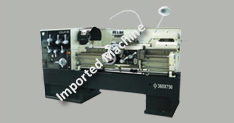Parts of a Light Duty Lathe Machine and its Operation
A light duty lathe machine is designed for small scale jobs at workshops and tool rooms. One can easily turn, drill, groove, shape, cut, knurl and create threads on the harder metal or wooden surfaces by using a light duty lathe at a workshop. As designed for small-scale industries and workshops, this is usually a compact machine tool which enables efficient storage without occupying much space at the workplace. A modern multitasking lathe machine can produce accurate end products from hard metal, plastic and wood surfaces and therefore is considered the best option for the small-scale industries where space is a constraint or limit.
A light duty lathe machine for metalwork can be employed for different operations at a workplace. Let us now have a look at certain important parts and applications of a light duty lathe.
Bed, headstock, tailstock, saddle, lead screw, tool rest, countershaft, top slide, cross slide, chuck and gears are some of the most essential parts found in a light duty lathe.
A light duty lathe performs drilling operations with a drilling tool held in its tail stock. The tail stock has a handle which can be efficiently used to penetrate drilling tool efficiently into the work piece to perform a drilling operation.
The bed is the bottom part of the lathe machine which acts like a base support for the machine upon which all the other parts are mounted in the machine. The work piece is placed on the base and held with the chuck. The chuck spins the work piece while the headstock allows the spindle to rotate at variable speeds. The tailstock holds the drilling tool and the carriage houses the cross slide, top slide and saddle which are also among the significant parts of the machine playing an important role to deliver efficient operation as per the requirements of the user.
Threading, grooving and chamfering are some the operations that can be easily employed with a light duty lathe at a workshop. In the threading operation, the tool is inserted into the work piece at a constant speed. For the operation to perform, the lead screws are connected to the driving mechanism through gear trains which in turn  are attached with a carriage assembly. While grooving is performed with a grooving tool fed perpendicular to the rotating work piece, the edges of the object can be silt or cut to give an efficient chamfering operation with drilling tool. Visit http://www.yashmachine.com/wm-series-light-duty-lathe/ to know in detail about light duty lathe offered by leading machine tools manufacturer in India.
are attached with a carriage assembly. While grooving is performed with a grooving tool fed perpendicular to the rotating work piece, the edges of the object can be silt or cut to give an efficient chamfering operation with drilling tool. Visit http://www.yashmachine.com/wm-series-light-duty-lathe/ to know in detail about light duty lathe offered by leading machine tools manufacturer in India.
Conclusion:
Therefore with combination of different operations and with efficient use of parts of the light duty lathe, highly precise tasks as per the desired requirements can be performed at the workplace. Therefore several types of operations can efficiently be performed with a light duty lathe machine.
This article educates reader about light duty lathe machine, its parts and operations.
- How Lathe Machine Manufacturers are Powering the Nation’s Engineering Growth in Canada?
- How Chamfer Machines Are Streamlining Metalwork in the UK’s Manufacturing Sector?
- How Feed Rate Adjustments Improve Surface Finish in Vertical CNC Milling Machines?
- How Radial Drilling Machines Achieve Low Vibration and Distortion Resistance?
- From Design to Execution: How CNC Press Brakes Ensure Seamless Workflow
- How to Optimize Sheet Metal Operations Using a Hydraulic Press Brake?


